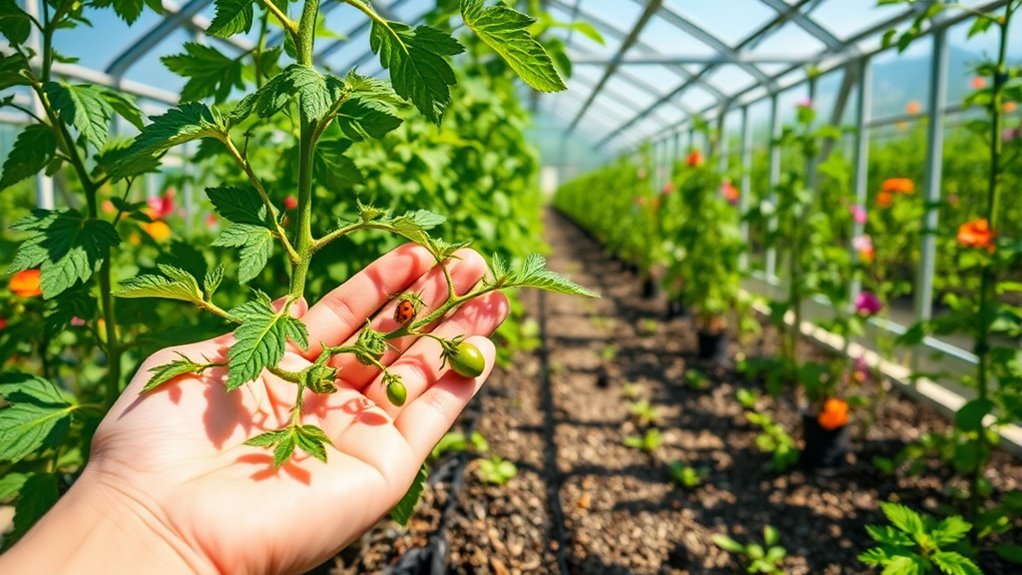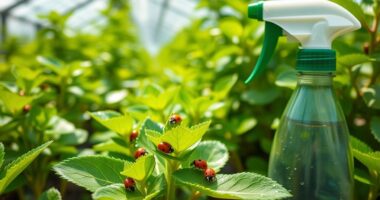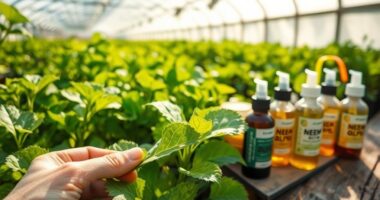Integrated Pest Management (IPM) for greenhouse gardens combines various control methods to keep pests in check while protecting the environment. Focus on sanitation, regular monitoring, and using biological controls first. If pests exceed thresholds, you can use targeted chemicals responsibly. Enhance your gardening practices by managing the greenhouse environment and implementing mechanical strategies like barriers and traps. Each step you take builds a healthier garden. Discover more effective techniques to guarantee your greenhouse thrives.
Key Takeaways
- Implement regular monitoring of pest populations to establish action thresholds and inform management decisions in greenhouse gardens.
- Utilize biological controls like predatory mites and ladybird beetles as the first line of defense against common pests.
- Maintain a clean and organized greenhouse environment through sanitation, crop rotation, and weed management to prevent pest infestations.
- Employ mechanical strategies such as sticky traps and physical barriers to reduce pest entry and capture flying insects.
- Use targeted chemical applications responsibly when pest populations exceed thresholds, following label instructions to minimize environmental impact.
Understanding Integrated Pest Management (IPM)
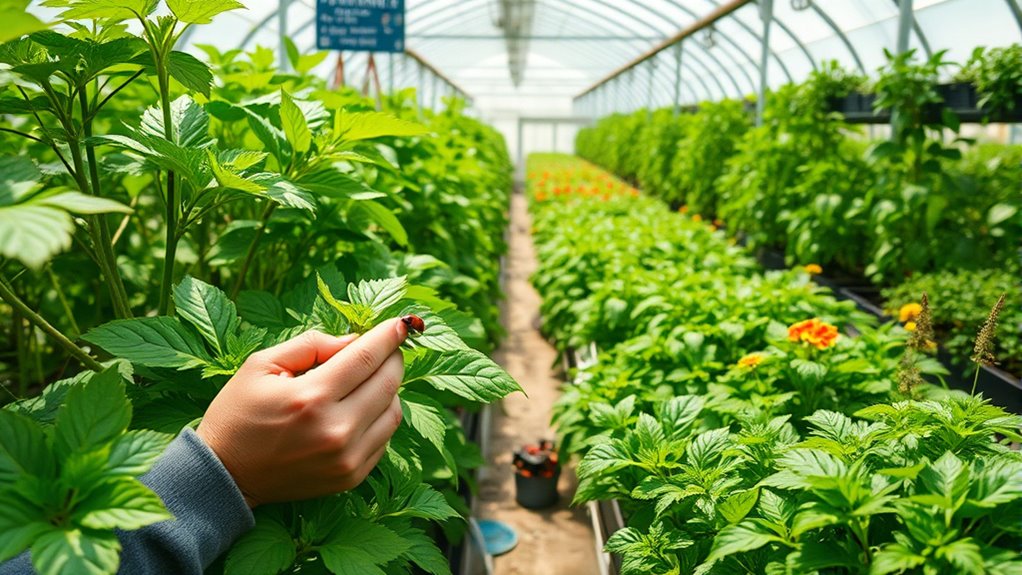
While pests can pose significant challenges in greenhouse gardens, understanding Integrated Pest Management (IPM) offers an effective way to tackle these issues. IPM combines various control methods, emphasizing minimal environmental impact.
You'll focus on sanitation, monitoring, biological control, and the judicious use of chemicals, ensuring you reduce risks to both people and the environment. By regularly monitoring pest populations, you can determine action thresholds that guide your responses.
Biological controls, like natural enemies, often serve as your first line of defense, while targeted chemical options are reserved for emergencies. Implementing IPM not only saves costs but also sustains high-quality plants.
This adaptable approach supports diverse gardening settings, making it a valuable strategy for every greenhouse gardener.
Cultural Practices for Pest Prevention
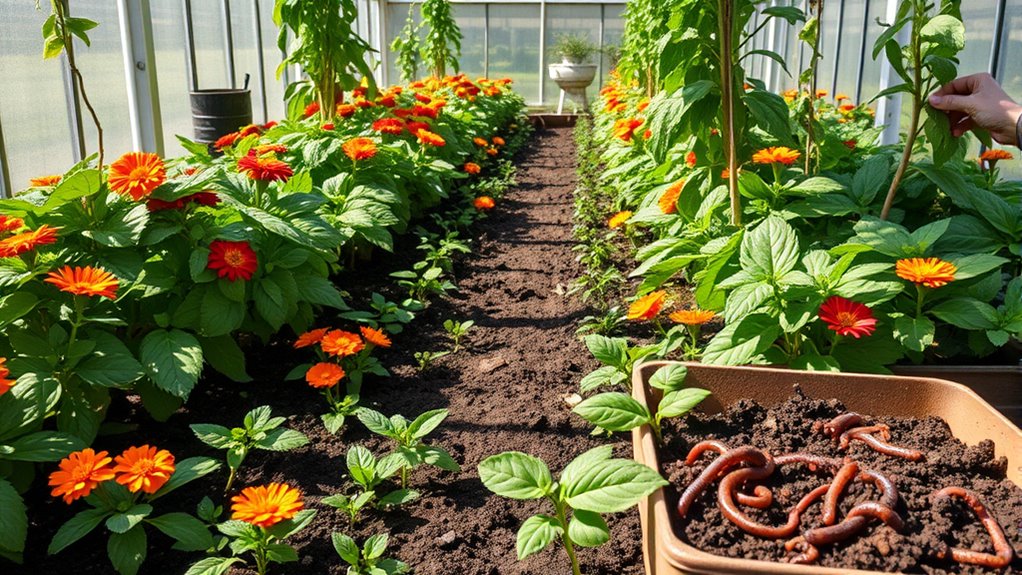
Integrated Pest Management (IPM) involves various strategies to keep your greenhouse garden thriving, and cultural practices play an essential role in pest prevention.
Start by managing your greenhouse environment; adjust light exposure, control temperatures, and maintain humidity to keep plants healthy and less vulnerable to pests. Improve air circulation to reduce moisture and prevent disease spread.
Manage your greenhouse environment by adjusting light, temperature, and humidity to enhance plant health and reduce pest vulnerability.
Rotate your crops and schedule plantings to disrupt pest life cycles, and avoid overcrowding to minimize infestation risks. Maintain weed-free zones and practice regular sanitation to limit pest harborage.
Choose pest-resistant varieties and monitor plant health closely. By implementing these cultural practices, you'll create a more resilient greenhouse garden that naturally deters pests and promotes healthy growth.
Mechanical Strategies to Control Pests

Mechanical strategies offer effective ways to control pests in your greenhouse garden. Start by using physical barriers like insect screens to keep airborne pests out.
Sticky traps are great for capturing flying nuisances like whiteflies, while high-pressure water can dislodge aphids and mites from your plants.
Regularly prune and rogue infested plants to halt pest spread. Vacuuming is another practical option for physically removing pests.
These methods are environmentally friendly, low-cost, and provide immediate results without harming beneficial insects. However, be prepared for the labor involved, as these strategies require consistent monitoring and maintenance.
Integrating these mechanical tactics with other pest management methods can enhance your overall success in maintaining a healthy greenhouse environment.
Utilizing Biological Controls in Greenhouses
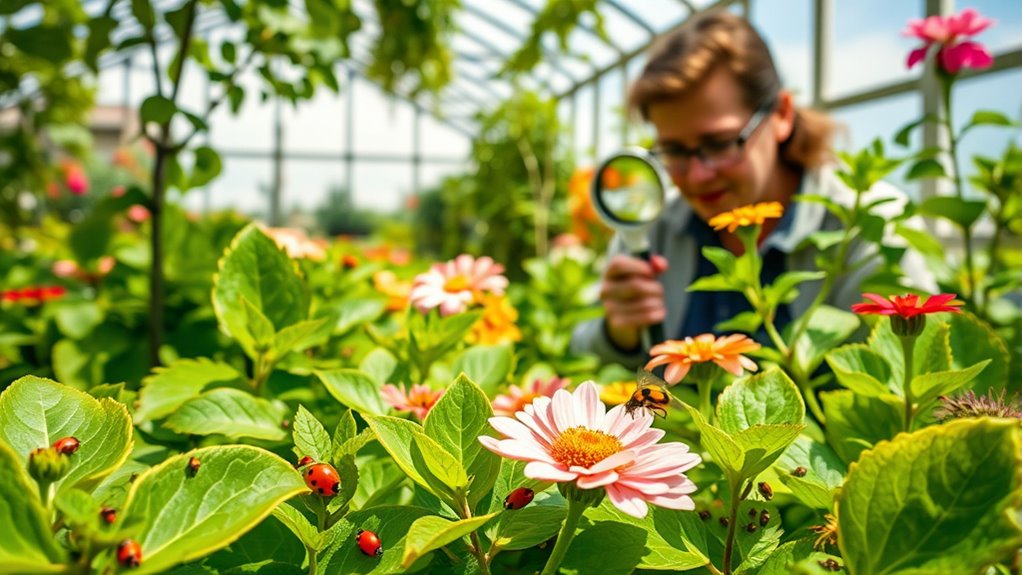
Biological controls are a powerful tool for managing pests in greenhouses, offering a sustainable alternative to chemical pesticides.
You can introduce predatory mites to tackle spider mites, with each consuming up to 20 a day. Ladybird beetles are excellent for controlling aphid populations, while lacewings feast on various pests, including mealybugs and thrips. Parasitic wasps target specific pests like whiteflies, and minute pirate bugs handle thrips effectively.
Timing is vital—release these agents before pest populations peak, and maintain ideal environmental conditions for their success. Regular scouting and record-keeping help you monitor pest levels and evaluate control efficacy.
Chemical Solutions and Their Responsible Use
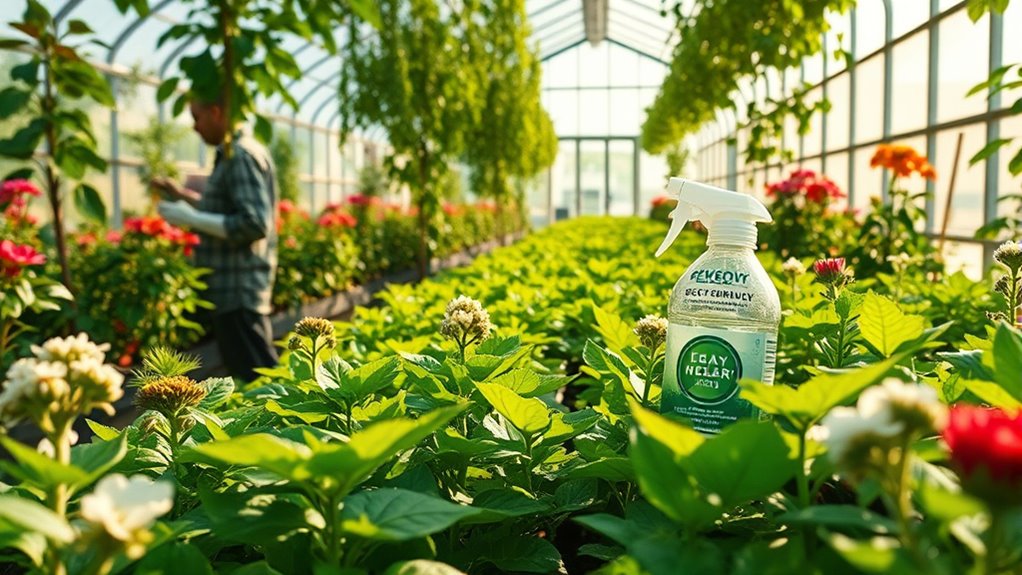
While biological controls are often prioritized in integrated pest management (IPM), chemical solutions play an essential role when pest populations exceed economic thresholds.
You'll need to choose pesticides wisely, considering factors like pest type, plant species, and environmental impact. Always follow label instructions and comply with local regulations to guarantee safe and legal use.
Targeted applications minimize environmental harm and reduce the risk of pest resistance. When possible, opt for lower toxicity options to protect human health and biodiversity.
Targeted pesticide applications safeguard the environment and human health while mitigating the risk of pest resistance.
Keep thorough records of your applications for monitoring effectiveness and compliance.
Effective Implementation and Monitoring of IPM
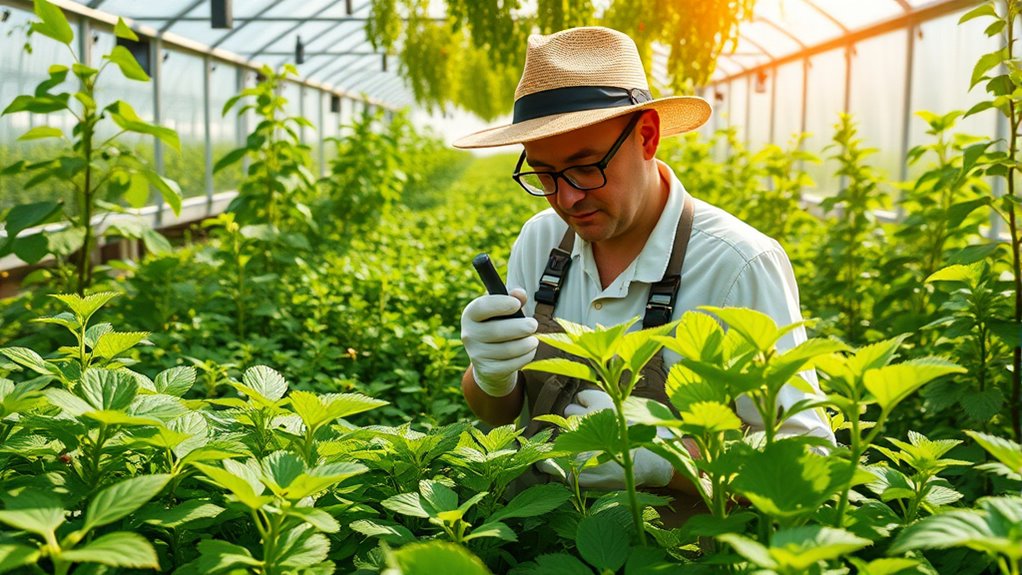
To successfully implement Integrated Pest Management (IPM) in your greenhouse garden, it's crucial to integrate various strategies tailored to your specific environment.
Start with cultural practices like adjusting soil moisture and ensuring good airflow to minimize pest conditions. Incorporate biological controls, using natural predators to keep pest populations in check.
Employ mechanical strategies, such as physical barriers and prompt removal of infested plants. Establish a monitoring system with regular inspections and sticky traps to catch pests early.
Keep detailed records of your pest management activities for future reference. Engage in team collaboration and periodically reevaluate your thresholds, adjusting your strategies based on pest activity and environmental changes.
This proactive approach will help maintain a healthy greenhouse garden.
Benefits of Adopting IPM in Greenhouse Gardens
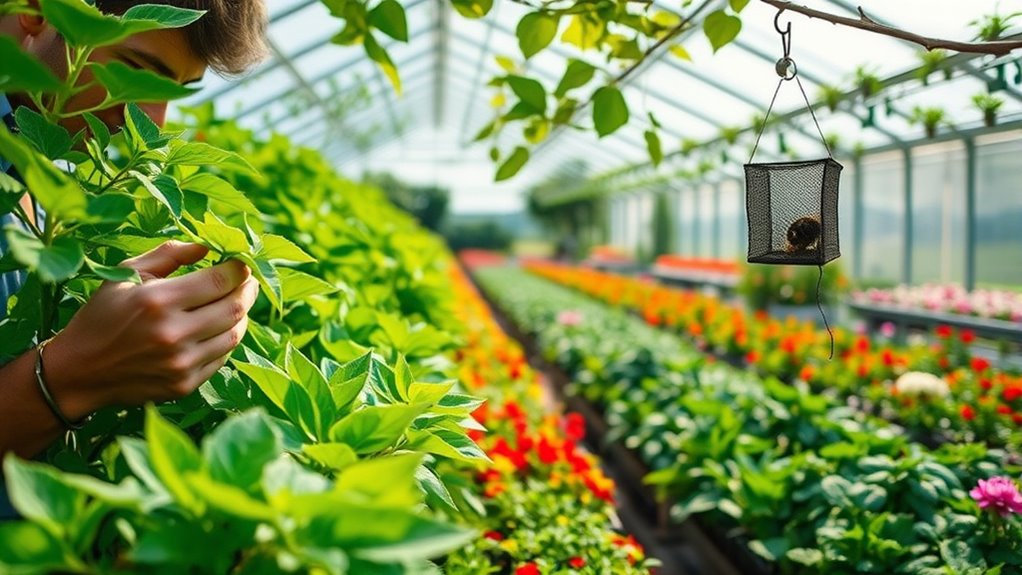
Adopting Integrated Pest Management (IPM) in your greenhouse garden offers numerous benefits that enhance both productivity and sustainability.
You'll reduce chemical pesticide use, protecting the environment and beneficial organisms while ensuring worker safety. This lower reliance on chemicals can lead to significant cost savings and helps prevent pests from developing resistance, promoting long-term effectiveness.
IPM also supports healthy plant growth and disease prevention, leading to higher crop quality and better market competitiveness. Additionally, it fosters biodiversity and maintains a balanced ecosystem, which boosts overall plant resilience.
Frequently Asked Questions
How Long Does It Take to See Results From IPM Practices?
You'll typically see results from IPM practices within a few weeks to a few months.
The speed of results depends on the strategies you implement and the specific pest issues you're facing.
By regularly monitoring and adjusting your approach, you'll notice improvements in pest populations and plant health.
Stick with it, and you'll likely find that your efforts lead to reduced pest presence and a healthier environment for your plants over time.
Can IPM Methods Be Applied to Outdoor Gardens as Well?
Absolutely, you can apply IPM methods to outdoor gardens!
By utilizing strategies like biological control, cultural practices, and mechanical methods, you'll effectively manage pests while minimizing chemical use.
Start with pest identification and regular monitoring to stay ahead of infestations.
Adjust your gardening practices and introduce natural predators to create a balanced ecosystem.
This approach not only helps maintain a healthy garden but also promotes sustainability and cost-effectiveness over time.
What Are the Costs Associated With Implementing IPM in Greenhouses?
Imagine transforming your greenhouse into a thriving oasis while keeping pests at bay.
Implementing IPM involves upfront costs like software, training, and biological controls, plus ongoing expenses for monitoring and maintenance.
You'll need to invest in infrastructure adjustments and possibly consultation fees.
However, these costs can lead to significant savings over time through reduced pesticide use, improved crop quality, and increased yields.
Ultimately, it's about cultivating a sustainable future for your garden.
How Do I Know if My IPM Plan Is Successful?
To determine if your IPM plan is successful, monitor pest populations regularly and track any changes.
You should also assess crop quality and yield by comparing them to previous seasons.
Keep detailed records of your pest management activities and analyze the data for trends.
If you notice reduced pest issues, lower chemical use, and healthier plants, you can confidently say your IPM plan is working effectively.
Are There Specific Pests That IPM Does Not Effectively Control?
Yes, there are specific pests that IPM doesn't effectively control. For instance, high-reproduction pests, like certain aphids, can overwhelm biological controls.
Additionally, nematodes and invasive species, such as the brown marmorated stink bug, often require more aggressive measures.
Pests with complex life cycles also pose challenges, making targeted strategies essential.
When facing severe infestations or immediate relief needs, you might find IPM insufficient without supplementing it with other control methods.
Conclusion
By embracing integrated pest management, you'll cultivate a healthier greenhouse garden and foster a flourishing ecosystem. With a blend of cultural care, mechanical methods, biological benefits, and mindful chemical choices, you can combat pests while protecting your plants. This proactive approach not only preserves your precious produce but also promotes sustainable practices. So, step into the world of IPM and watch your garden thrive, turning potential pest problems into productive possibilities!
